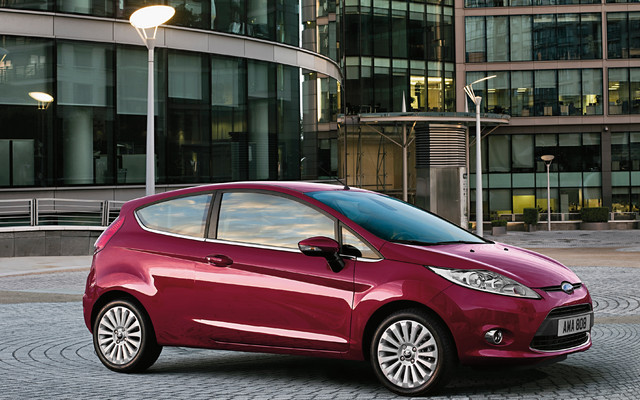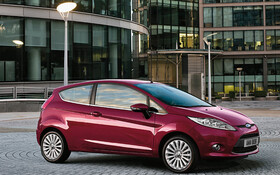Ford Fiesta: Pow! Right in the kisser!

| Strong points |
|
|---|---|
| Weak points |
|
The older people out there will remember the Ford Fiesta, which was sold in North America from 1978 to 1980. This same Fiesta is being brought back after a 30 year absence, but with a wonderfully modern shape and offering such evolved handling that other sub-compacts are sure to turn green with envy.
The 7th generation Fiesta, assembled at the plant in Cuautitlan, Mexcio, will only arrive next summer. Nonetheless, Ford wanted us to test it right away, and good on them for it: the European version tested has absolutely nothing in common with any other econobox.
Basically, despite the stiffer competition, notably with the autumn 2010 projected arrival of the Mazda2 (which has the same platform as the Fiesta), our market is sure to go wild over the 2011 Fiesta.
Of course, the price of the little Ford will have to be competitive, and for now, it’s hard to believe that the American manufacturer will be able to offer it for around $13,000...
A calculated risk
The best road tests are direct comparisons: An eye for an eye and a tooth for a tooth.
By putting its Fiesta up against the Honda Fit, the Toyota Yaris and the Nissan Versa, Ford was taking a risk. It was a calculated risk, however, since they knew we’d love it.
It’s hard to know why Ford didn’t think it wise to compare the Fiesta with the Hyundai Accent. Perhaps it was because the Accent is the only sub-compact, on our market anyway, to offer optional heated seats, which are also offered by the European Fiesta.
Fit and Fiesta…Fiesta and Fit
On a zigzagging route with a smattering of abrupt stops, the Fiesta really showed what it could do. It was clearly more dynamic than the Toyota Yaris and its much too soft suspension. It was also more precise than the Nissan Versa, which suffered because of a half-second lag in the reaction of its power steering, enough to take out a few pylons set up along the course...
The Honda Fit fared much better, and it will certainly be the Fiesta’s most serious competitor. Or will the Fiesta be the Fit’s most serious competitor?
Specs yet to be determined
Before I continue, you should know that the technical features of the 2011 North American Fiesta are still not all decided, and tip-lipped Ford is saying only that it will come in a four-door sedan and a five-door hatchback, which is the version we tested.
While it still isn’t official, it’s a safe bet that the Fiesta will feature the 1.6-litre four cylinder engine, which is currently the most powerful engine in the European line with its 119 hp and 109 lbs-ft of torque.
At that, the Fiesta is already better than anything that competition, whose engines range from 106 to 117 hp, has to offer. This engine goes from 0-100 km/hr in less than ten seconds, a full second faster that the average for the category.
European flavour
The Fiesta that we tested benefitted from having a European flavour. In other words, it had a very firm suspension (let’s hope that the North American adjustments won’t include making the suspension softer), precise steering (hard to believe that it’s power steering) and an unrivalled equipment level among sub-compacts. We’re talking leather upholstery, rain sensing wipers, automatic climate control, keyless drive, heated seats…
On the highway, the Fiesta is solid, agile and fun to drive. After all, 119 horses is a lot to power a little car, so it won’t let you down when you need it most.
The manual transmission, the only one available for testing, shifts pleasantly from gear to gear. However, at highway cruising speed and when the engine is revving at 3,000 rpm, it could use a sixth gear. Obviously, there will be an automatic version for North America, but we’ll have to wait for details about the technology and/or the number of speeds.
A compact sub-compact
Next to its rivals, the Fiesta appears even smaller and its friendly “jelly bean” face is one of, if not the shortest, of the lot. Fortunately, it still has decent cargo space. It can take a load of up to 965 litres once the bench is lowered. The hatch is light and opens high enough so that big heads won’t have to worry about bumping into it.
The Fiesta isn’t as tall either, and that translates to less favourable head room in the back. On the other hand, in the front seat, even with a big strapping lad next to you, you won’t feel claustrophobic.
The little Ford’s passenger compartment is unquestionably its own best advertisement. A real style coup, the dashboard is unlike anything on the market and the big steering wheel ensures a commanding presence. The front seats are comfortable and the manufacturing quality, soundproofing, and even materials are far and away superior to what you could rightfully expect from a sub-compact.
Nothing is perfect however, so we should mention that the rear headrests are uncomfortably prominent and the air conditioning doesn’t cool down the passenger compartment sufficiently.











